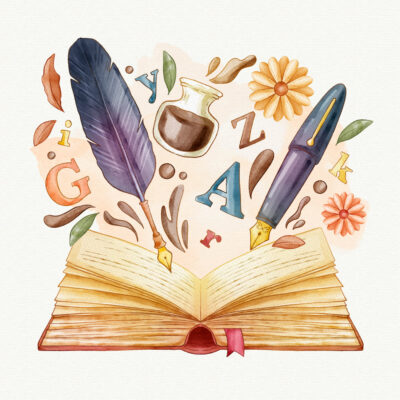
CRASH COURSE ON LITERATURE (CCL): PART 3

CCL: PT. 3
By N. O. Ewelike ACArb.
PART-THREE: LITERARY TERMS
 Literary terms are technical devices used both in prose and poetry by an author or by the poet when appreciating works of art in order to communicate their thoughts and feelings to the readers, so as to enhance the readers’ understanding of the theme and form of a piece of writing.
Literary terms are technical devices used both in prose and poetry by an author or by the poet when appreciating works of art in order to communicate their thoughts and feelings to the readers, so as to enhance the readers’ understanding of the theme and form of a piece of writing.
Kinds of Literary Terms:
Stanza:
In poetry, we have what is called stanza. A poem is usually written in divisions known as stanza. A division could contain two lines or more. This pattern of stanza formation could be reflective of the thought process of the poet.
- Monometer – a line stanza
- Couplet – a two line stanza
- Triplet – a three line stanza
- Quatrain – a four line stanza
- Quintet – a five line stanza
- Sextet – a six line stanza
- Septet – a seven line stanza
- Octave – an eight line stanza.
Rhythm:
This is the precise flow of metrical movement between sound and events. It most essentially synchronizes with sound and through a good rhythmic pattern, a song like effect is usually achieved.
Mood/Tone:
This is the state of mind of the author when making his composition. It reflects the feeling of the writer which the reader cannot feel except through the words of the work.
Rhyme:
This is the correspondence in sound of word-endings, usually at the end of poetry lines. Rhyme is much of poetic device whereby the final sound of words are similar. E.g. He stumbled through the gate.
When I was having my date.
Enjambment:
This is also known as run on lines. It occurs in poetry with the idea in a line running into another as a single line and may not complete the message until next one. Example:
When the world rises
In the early hours
Both animate and inanimate objects
Give glory to the lord.
Imagery:
In literary sense, it means the collection of images within a literary work or unity of a literary work. Imagery in literature could be based upon the physical world, upon the psychological state of the setting in which the work is produced. Example: “this is the bamboo stick that vomits fire” – the bamboo stick is not the bamboo stick we know but an imagery of the gun.
Allegory:
This is an extended metaphor in which objects, person, and action in a narrative, either in prose or verse, are equated with meanings that lie outside the narrative itself. It brings a vivid representation of events, characters, setting and ideas through images in which they can on deeper reflection, be perceived. An example of such prose work is George Orwell’s – Animal Farm which represents the societal ills of perversion of communism by the Russian leaders after October 1917 revolution.
Satire:
Satire is a term used for a literary manner blending a critical attitude with humor and wit; for the purpose of improving human institutions or humanity. It holds up society to ridicule or it shows the foolishness of an idea or custom in an amusing manner evoking laughter, contempt, or scorn.
Rhetoric:
This is the art of using words persuasively in speech and writing. It involves a manner in which the listener would be persuaded to respond in the way the speaker wants.
Rhetorical Questions:
As in the above, rhetorical question is a leading question whereby the questioner subtly presents his question as if expecting to get the anticipated response. In a nutshell, it is a question in which no answer or reply is expected. The purpose of such a question is to lay great emphasis on something and to show a deep thought for it.
Flashback:
This is a narrative technique used by a novelist or a playwright to present in a recounting manner an event in the life of a particular character. That is, through this technique a past action without which a missing link in a story or play would have created a confusion, is supplied afterwards.
Dilemma:
This is a situation whereby a person is faced with two dangerous situations between which he has to choose. One is as undesirable as the other.
Humour:
This is a way of presenting events in a way to induce laughter. It could be satirical or witty. Thus, the statement is intended to pass good humour.
Fable:
This is a short story (tale), told to teach moral lesson. It is often told with animal representation of human beings and quite common in folktales.
Repetition:
We use repetition as a style for the purpose of emphasis and making impression, we repeat certain words or phrases. Example:
“Ride on, Ride High
Halleluya, the son has come
Ride, for the ass is yours”
Metre:
Metre occurs when a person’s voice goes up or down at regular intervals in the pronunciation of a word.
Atmosphere:
This refers to the prevailing mood, feelings, and thought of actions of people in a story. For example: striking and clanging of swords, thundering of airspace may combine to portray an atmosphere of fear, anxiety, and crisis.
Elegy/Dirge:
This is a song of sorrow, mourning. It is a song that mournfully celebrates an event like the death of a relation.
Ballad:
This is a sort of poem often handed down from generation to generation. This means that its largest part is preserved through memory. It usually has themes celebrating legends and village heroes.
Didactic Poem:
Just as its name suggests, a didactic poem is one that seeks to teach or instruct people on the essence of morality such a poem is purposely designed to correct the moral degeneration in society by teaching people on correct mode of behavior.
Epic:
This is a long poem narrating the heroic deeds of a people or of some great men. The epic hero usually excels in courage, nobility, etc.
Ode:
This is a poem written or spoken like direct address to an object or to a person not present as if he were present. The pome is usually nostalgic in nature..
Setting:
This is the physical periodic background in which a particular work of literature is written. It may be a local or urban background or setting while the periodic setting may be during colonial days or of earlier post-independence days which help us to be able to fit in the story in the imagination of the setting.
Lyric:
This is derived from the Greek word “Lyrikos” which means a poem to be sung on lyre. Lyrics are found at Ceremonies such as: marriage, funeral, etc.
Diction:
This is the vocabulary, language, or choice of words of an author. It is the manner of expressing one’s ideas using words.
Character & Characterization:
A character means a participant in any work of art. The character in one way or the other participates and therefore contributes to the meaning and development of the literary work, especially in novels and plays although they are called actors and actresses in the case of a play.
When a character changes in the course of the play or novel, he or she is referred to as dynamic or a round character while a character that remains unchanged is called a static or flat character.
A character can also be a protagonist, meaning the central character, a character that commands attention and whom the entire story Centre’s around. An antagonist is the person who directly opposes the hero; is usually the villain in the story.
Plot:
This is the arrangement of events in a work of art. It simply indicates the sequential manner in which one event leads to another.
Theme:
This is the pre-occupation of the writer. It simply reveals what the writer had in mind before picking his or her pen to write. It contains what the writer wants the readers to know and the message he wants to pass across to his readers.
Prologue/Epilogue:
Prologue is a preface to a work of art. It is the introductory speech made at the beginning of a text. In short, it is a pointer to the events preceding the actual story itself. And it helps in making the readers aware of the events that will influence the actual story. Epilogue is the direct opposite of prologue. It is the speech made at the end of the story/play. It may also be the summary of the main action or a concluding section of a literary piece.
Syllable:
This refers to a unit of sound. For example the word ‘to’ has a unit of sound when we pronounce it. It begins with the letter ‘t’ and stops at letter ‘o’. Likewise the word ‘educate’. It can be syllabified into three as ‘edu/ca/te’. The effect of syllable is to produce rhythm in a poem and to measure the length of a line of poetry.
Allusion:
This is a reference to something outside the immediate scope of what is being presented. It may be reference to characters, events in history, mythology, and works of literature.
Verse:
This is metrical composition of a song or lines of poetry.
Lineation:
This is the arrangement of poem in lines.
Anthology:
This is a collection of passages of poetry.
Catastrophe:
This is the tragic conclusion of a play or narrative.
Tone:
This is the language used by a writer, through it, we can know whether the mood of the speaker is good or bad.
Connotation:
This refers to the things suggested by a word. For instance, red connotes ‘danger’ or ‘blood’.
Denotation:
This is the lexical or exact meaning of a word. For example ‘Red’ denotes a particular color.
Novelist:
This refers to a writer of novel.
Setting:
This refers to geographical area or place and the time when a play or story takes place.
Style:
This is the method employed by a writer to present his or her views.
Episode:
This is the division of events in a novel.
